“Would You Like Milk With Your Peace?”
Mindfulness has become somewhat of a buzz-word over the past decade, but it’s more than just a fad.
Thich Nhat Hahn says in his book The Miracle of Mindfulness that mindfulness is a “serene encounter with reality”. Mindfulness is tool to experience moments with a sense of clarity, calm and connection.
Regular mindfulness allows us to be proactive about our state of mind. Studies have shown that mindfulness not only helps us take a breath in our busy lives but can also:
- reduce stress
- improve sleep
- decrease depression (and may help in prevention of relapsing into depression)
- increase the ability to regulate emotions
- relieve/reduce chronic pain
The beauty of mindfulness is that it’s a practice that fits around even the busiest schedules and can be exercised in less time than it takes to prepare and drink a cup of tea!
In fact, tea making and its consummation was, and still is, the focal point of one of the most ancient and sacred mindfulness rituals.
The History of Tea Rituals.
These tea rituals date back as early as the 2nd century in China, where Buddhist monks used tea in their meditation rituals. Eventually, tea rituals made their way to Japan, and toward the 17th century become much more ritualistic and elaborate.
From the exact placement of the teapot and teacups, down to the way the tea is poured and consumed, Japanese tea ceremonies (or chado in Japanese) were, and remain to be, incredibly intricate and intentional in their execution. So detailed are chado, that they are considered to be a classic art.
Creating Art.
Now, most of us don’t have the time to conduct a full-scale tea ceremony each day, but most of us can make time for a cup of tea. And sometimes art need not be so complex. Simple is sometimes just as sweet.
If we condense the idea and ritualistic elements of these mindful tea ceremonies, we can create our own small, yet impactful tea ritual that can connect us to our present moment, even if we only have a few minutes to spare.
A Cup of The Now
Experience mindfulness with this simple tea ritual:
Observe yourself in each moment. As you prepare your tea, notice what you are doing and how you are feeling. Notice your posture and what order you gather the things you need. What cup do you use? What spoon? What do you do as the water comes to temperature?
A way to support this is to commentate what you are doing, for example, ” I am opening the drawer. I am choosing this silver spoon. I am moving toward the stove..”
Engage your senses. When you sit down to drink your tea, work through the follow mindfulness prompts.
>>How does it feel when you wrap your hands around the teacup? How do you feel in all other places in your body, even in your mind?
>>Consider the teacup. Does it have any unique features, like a bold pattern or a crack in the rim? Is it a simple mug?
How about the tea itself? What color is it? Notice the color changing the longer it sits.
>>Now, close your eyes and breathe in deep. What aromas fill you? What emotions or thoughts are provoked by these scents?
>>Time to take your first sip. What temperature is the tea? How does it feel on your lips and as it travels through your body? What thoughts and/or emotions are provoked by its flavors?
Tea Magic and The Self.
This beautifully simple tea ritual serves as a medium to draw us into the now, where we can find the same serenity invoked through the elaborate tea ceremonies from ancient times.
It also gives us the honor of witnessing and experiencing our Self, exactly as we are in the moment we are living in.
Experience the mindfulness, uncover the mysteries, and relish in the magic, all within a cup of tea!







Read 0 comments and reply